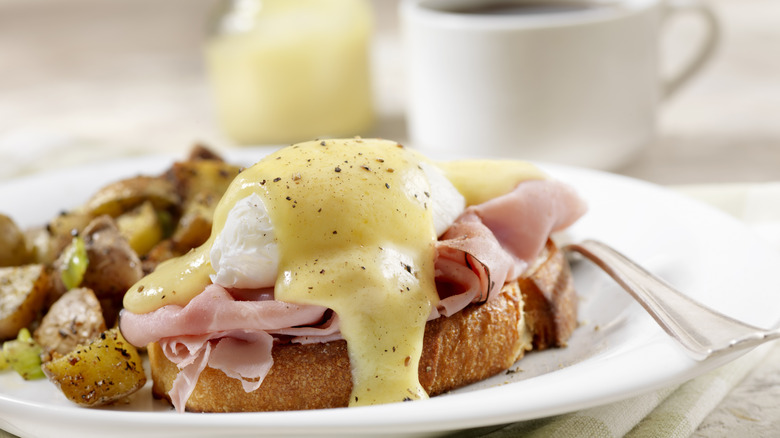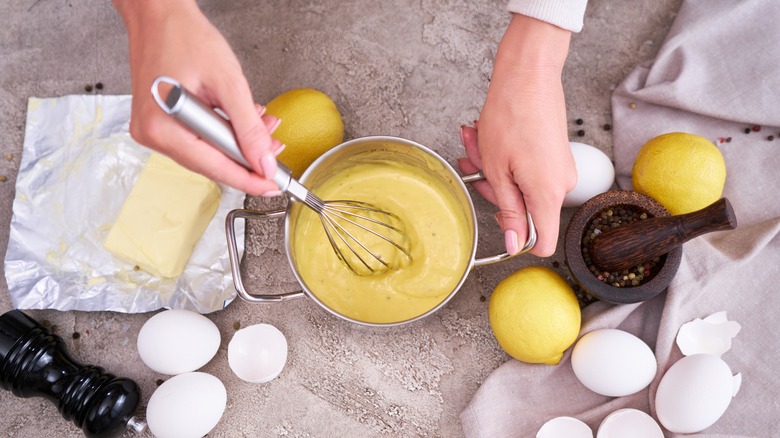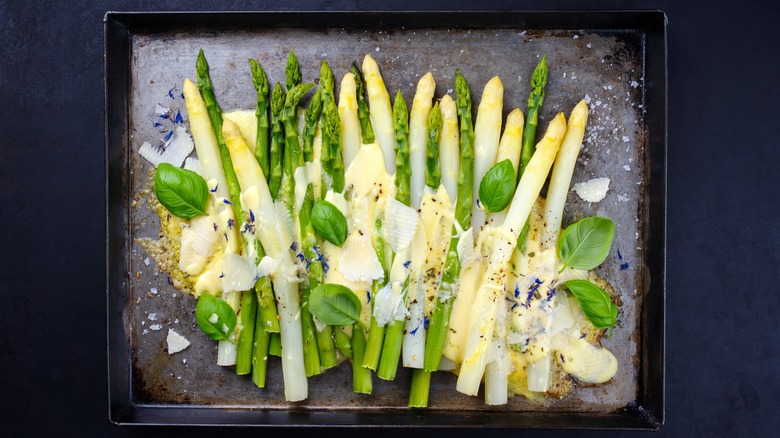The Mistake That Probably Broke Your Hollandaise Sauce And How To Fix It
Creamy hollandaise is the perfect topping to a classic eggs Benedict, but it can also be used as a sauce on top of anything from grilled veggies to seafood. Hollandaise is similar to béarnaise, as it's essentially a combination of egg yolks, lemon juice, and butter. Of course, the three ingredients together can become pretty delicate. Many people shy away from making it at home because it's earned a reputation for being more difficult than most sauces, and that's because Hollandaise is an emulsion (a combination of two or more ingredients that repel, such as fat and acid). If not made carefully, it can easily break.
Technique and temperature are both important here. You don't want to prepare the sauce too quickly, and you need to keep it at a steady temperature that isn't too hot, or you risk scrambling the eggs. But even if your hollandaise breaks because you got the temperature wrong, there's no need to panic or start over; the sauce can often be easily fixed, as long as you have a little extra time and some water.
How to fix broken hollandaise sauce
Not all hollandaise that's broken can be fixed. The sauce needs to cook at a temperature that's warm enough to help it combine, but not too warm that it starts to cook the eggs. Unfortunately, if the eggs turn into scrambled eggs, then there's nothing you can do, and you'll need to start over. But if it's a temperature issue and the hollandaise breaks, then you just need some water to patch things up. Breaking means that the fat from the butter has separated from the egg yolks – instead of the sauce having that creamy consistency we know, it becomes lumpy and unappealing.
If your emulsion has separated because it was too hot, just whisk in some boiling water slowly until the sauce reconnects. Only add a small amount at a time — no more than a tablespoon — until the sauce regains that creamy texture. If the sauce looks like it could break because it's too hot but hasn't broken yet, then you actually want to add a small amount of cold water while whisking, which will help bring it together. The same rules apply; add a little at a time. And if your hollandaise is too cold, the fat in the mixture could start to stiffen, causing lumps. In this case, hot water is still the answer: Add a little hot water at a time, or warm it up by placing it in a bowl on top of some hot water, to heat up that sauce and melt those fats.
How to prepare hollandaise to avoid breakage
Of course, the ultimate goal is to not have the sauce break at all. The best way to do this is to keep a consistent temperature and constant movement. The egg yolks and lemon juice should be whisked together before the sauce even hits any heat. From there, the heat should be set to medium-low, and the whisking needs to remain constant. Any stopping, and the eggs will overcook. But stovetops vary — the burners on a gas stove might let off different heat than an electric stove, so this might take a little trial and error to understand the best heat setting based on your stove.
The eggs should thicken but not cook. Don't add the butter until the eggs are frothy, then add it in small amounts of no more than a tablespoon while the whisking continues. Continue whisking until the sauce is frothy and thick, and remove it from its heat source before the whisking stops.
Hollandaise should be served soon after it's cooked to avoid it thickening too much as it cools. Yes, it's a bit tricky if you're making it for the first time, but once you understand the technique and your stovetop's ideal temperature, it comes together in minutes. And as long as those eggs don't start to cook, you can relax knowing that breakage isn't that big of a deal.


